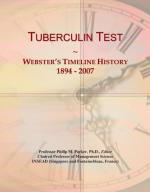|
This section contains 343 words (approx. 2 pages at 300 words per page) |
Tuberculin tests are used to detect the presence tubercle bacilli, the pathogen which causes tuberculosis (TB), a serious infectious disease that attacks the lung. Once well under control in the Western World, more than 400,000 new cases of this re- emerging disease are reported in industrial countries every year, and it kills more than three million people world-wide annually.
Tubercle bacilli was discovered by German bacteriologist Robert Koch (1843-1910) in 1882. Although unable to find a cure, Koch did find a way of diagnosing the disease. He developed a test for sensitivity to the tubercle bacilli in 1890, which gained him the 1905 Nobel Prize for physiology or medicine. Today there are several ways of testing for the presence of TB. For non-pulmonary TB, specimens are taken for biopsy or microscopy and culture. Pulmonary TB tests consist of chest X-rays and a sputum smear test to detect tubercle bacilli. The tuberculin skin test--administered in one of two ways--tests for tuberculolipoprotein hypersensitivity from previous infection only. The substance used in this test is a purified protein derivative (PPD) which comes from the filtrates of laboratory cultures of tubercle bacilli. The Mantoux test is an injection of tuberculin PPD into the skin of the forearm. The Heaftest, (or tine test), used more for mass screening of low-risk populations, involves smearing undiluted strength of tuberculin PPD on the skin of the forearm which is then punctured with a six-pin Heaf apparatus. In each case, a hardening of the skin within 48-72 hours causing inflammation over 10 mm in size indicates that the person was at some time infected with the TB bacteria. However, a positive test does not indicate active disease; previous immunization against TB will likely show a positive test.
The skin test currently used was developed by Dr. Florence B. Seibert, a biochemist, who first isolated the active protein in tuberculin and used it to make TB skin tests more accurate. If a person shows an inflammatory reaction, a physician may recommend a chest X-ray to see if there is a spot on the lung.
|
This section contains 343 words (approx. 2 pages at 300 words per page) |


